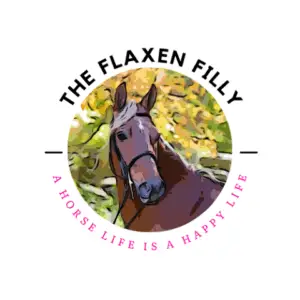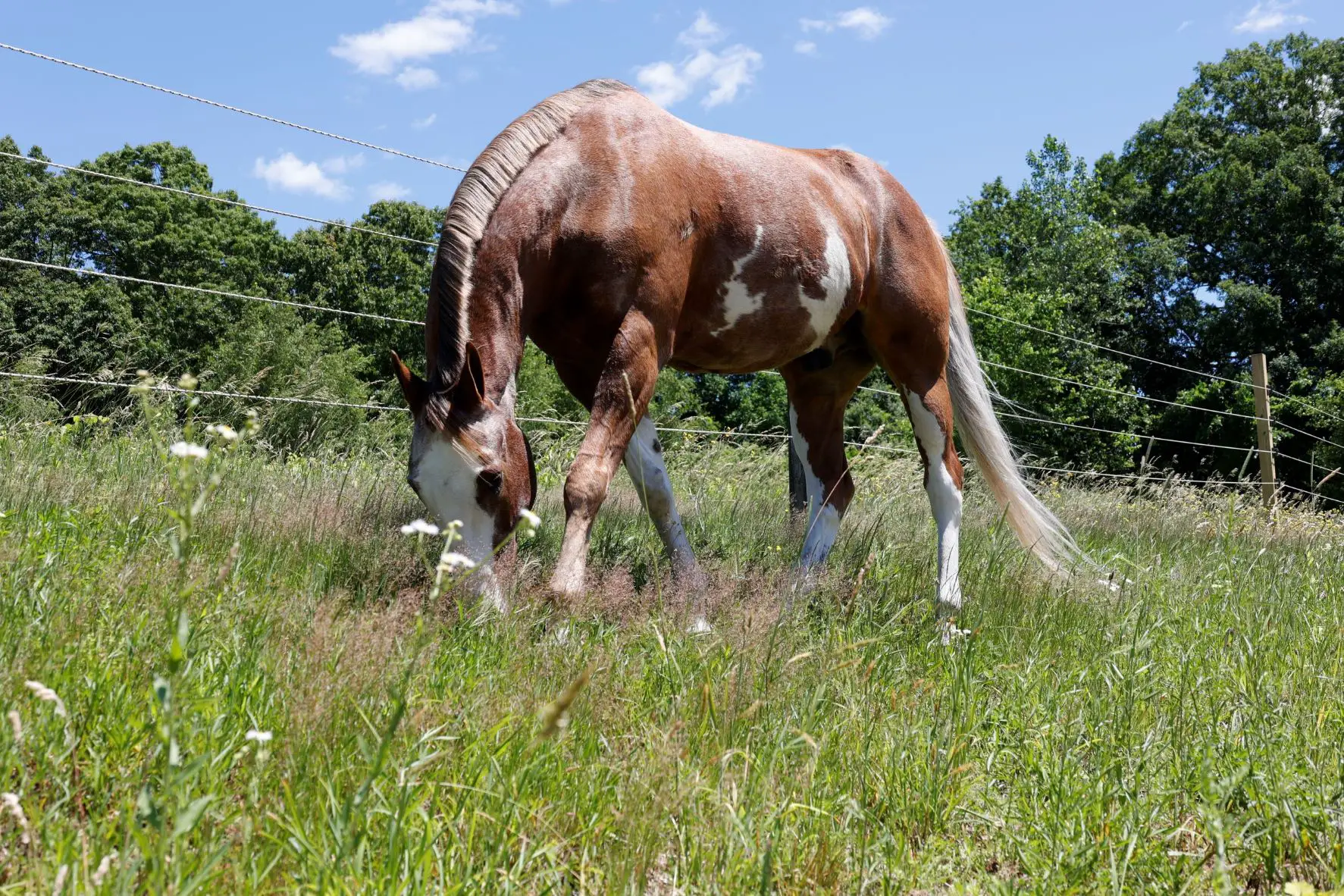In this article we’ll review some of the basic vocabulary beginner equestrians should know and learn as they get started with horses. This list of horse terms is by no means a complete and comprehensive guide but it is a good overview for new horse enthusiasts.
This post may contain affiliate links which means that I may earn a small commission at no extra cost to you. As an Amazon Associate I earn from qualifying purchases.
Horse Terms For Type, Age and Gender Of Horses
Foal: A baby horse that is still nursing from their mother.
Weanling: A baby horse around 6 months of age and younger than one year that is weaned from its mother.
Yearling: A baby horse that is one year old.
Colt: A young male horse 4 years old or younger.
Filly: A young female horse 4 years old or younger.
Mare: An adult female horse older than 4.
Gelding: A neutered male horse.
Stallion: An adult male horse older than 4 that has not been gelded.
Mare In Foal: A pregnant mare.
Sire: The father of a horse.
Dam: The mother of a horse.
Pony: A small horse under 14.2 h that is full grown.
Equine: The name of the species which includes horses, donkeys, mules and zebras.
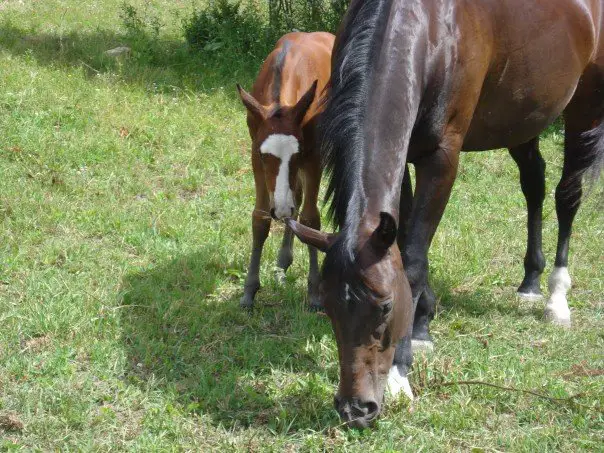
Common Horse Breeds You May Hear Of
Quarter Horse
Paint Horse
Pinto Horse
Appaloosa
Thoroughbred
Arabian
Morgan
Mustang
Welsh Pony
Warmblood
Shetland Pony
Haflinger
Clydesdale
Shire
Want to learn more about horses? Check out The Complete Book Of Horses
Horse Terms For Common Coat Colors
Bay: brown with black mane and tail and black legs
Chestnut/Sorrel: dark or light red colored, mane and tail are the same color as coat.
Black: black coat with black mane and tail.
Grey: Some grey horses actually look white, these horses are called grey because their skin is black even though their hair is white, so when the horse is wet, they look grey. Some greys are darker and have dapples (known as Dapple Grey) while others are almost white and have small flecks of black or dark grey hair, called Flea Bitten Grey.
Palomino: Golden or yellow colored coat with flaxen mane and tail. Flaxen is a blonde or almost white color.
Buckskin: Tan hair with black mane and tail
Dun: Golden or tan coat with black mane and tail and a dorsal stripe.
Roan: White hairs mixed in with the coat color such as black or chestnut create a blue roan or red roan, respectively.
Horse Terms For Coat, Face and Leg Markings
Tobiano: A type of coat pattern on a paint or pinto horse where the white crosses over the horse’s back or neck. Tobianos tend to have more white than color on their bodies.
Overo: A type of coat pattern where the white stays within the frame of the body and does not cross over the horse’s spine from one side the other. Overos typically have more colored hair than white spots.
Bald Face: Wider than a blaze, white that starts above the forehead and stretches down to the muzzle .
Blaze: Thick white stripe on the horse’s face.
Star: White dot on the horse’s forehead, size and shape will vary.
Strip: Thin stripe down the horse’s face, sometimes connected to a star and snip.
Snip: White spot on the horse’s nose.
Sock: White leg marking from hoof to mid-cannon bone or lower.
Stocking: White leg marking from hoof to knee or hock.
Dorsal Stripe: A black stripe that goes down the horse’s spine, commonly seen in dun horses.
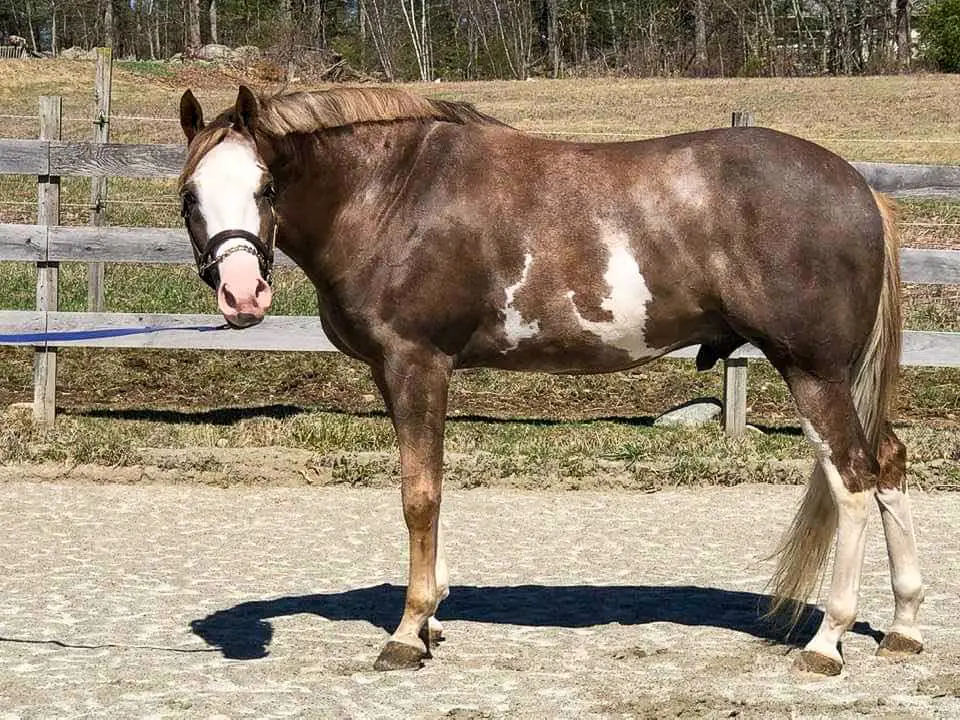
Horse Terms For Parts Of The Horse
Muzzle: The horse’s mouth and nose, nostrils and chin.
Forelock: The hair between the horse’s ears that grows down over the forehead, similar to bangs!
Bridle Path: The very top of the mane starting behind the forelock, from the top of the horse’s poll which is typically clipped short in order for the headstall of the bridle and halter to rest behind the ears.
Mane: The hair that grows all the way down the horse’s neck.
Withers: The highest point of the horse between the base of the horse’s neck and back and where we measure a horse’s height.
Barrel: The large, round mid-section of the horse.
Loin: The area of the horse behind where the saddle sits.
Croup: The rump of the horse.
Dock: The top of the tail.
Hock: Large joints on the hind legs that look like knees.
Cannon Bone: The part of the leg between the knee or hock and the fetlock.
Fetlock: The joint below the cannon bone and above the pastern which looks similar to an ankle.
Pastern: The part of the leg below the fetlock and above the hoof.
Hoof: The horse’s feet.
Frog: The triangular groove in the bottom of the horse’s hoof.
Hindquarters: The back end of the horse including the hip, hind legs and tail.
Coronet: The top of the hoof where the hoof and skin connect.
Crest: The top of the horse’s neck.
Stifle: The large joint below the horse’s hip which is similar to a humans knee.
Gaskin: The muscle located on the hind legs above the hocks and below the stifle.
Ergot: A hard growth on the back of the fetlock.
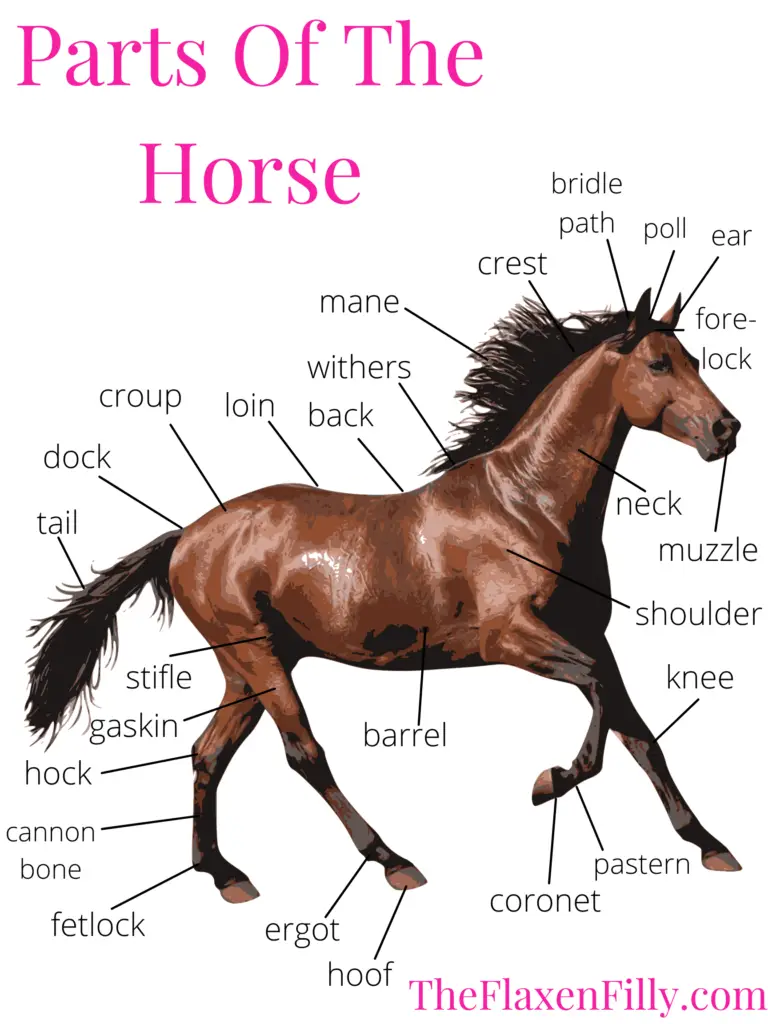
Horse Terms For Horse Tack & Equipment
Tack
Tack: A broad term that describes the horse equipment used for riding such as saddle, bridle and girth.
Saddle: There are many varieties of saddles ranging from jumping saddles, dressage saddles, all-purpose saddles, western saddles, barrel racing saddles, trail saddles and more! Regardless of the discipline you choose to ride, a saddle will make your ride more comfortable and help you learn to balance!
Saddle Pad: A soft rectangular or contoured pad placed underneath the saddle.
Girth: Similar to a belt, used around the horse’s mid-section to hold the saddle on.
Stirrups: The part of the saddle in which the rider places their feet.
Bridle: Made of leather and fits over the horse’s head and is attached to a bit and reins to help control the horse as you ride.
Headstall: The top part of the bridle that goes over the horse’s head behind the ears.
Bit: Bits come in many shapes and form but are typically made of metal and sit in the horse’s mouth. The bit is attached to the bridle and reins to steer and give other queues to the horse.
Reins: Reins are made of thin leather that connect to the bit. Riders hold the reins while riding in order to stop and steer the horse.
Halter: Made of leather or nylon, the halter is worn over the head and is used to lead the horse and control them from the ground. Unlike a bridle, the halter does not have a bit.
Lead Rope: A rope which attaches to the halter to control the horse from the ground.
Breast Collar: Attaches to the saddle and is placed over the horse’s neck and shoulders to help prevent the saddle from sliding back.
Martingale: There are multiple types of martingales which attach from the girth to the reins or noseband of the bridle. This is used to help prevent the horse from being able to put their head too high up in the air. The horse can still move their head and neck.
Equipment
Fly Mask: A mesh mask horses wear when turned out in order to keep the flies out of their eyes and ears while still allowing them to see.
Riding Crop: A short whip used gently to help encourage the horse to go forwards.
Lunge Line: A long rope much longer than a lead rope used to lunge a horse or exercise them from the ground.
Lunge Whip: A long whip used to encourage the horse to move forward when being lunged in a circle. This type of whip is only used from the ground and is not carried by the rider.
Spurs: An artificial aid worn on the boots of the rider to help give more precise queues to the horse.
Sweat Scraper: A plastic, rubber or metal tool that removes excess water from the horse.
Leg Wraps: Bandages that wrap around the horse’s legs to protect them during exercise or travel.
Horse Boots: Protective boots the horses wear to keep their legs free from injury during exercise.
Bell Boots: Round boots rubber boots that prevent the horse’s from losing a shoe.
Grooming Terms
Curry Comb – a round rubber brush with teeth, used in a circular motion to lift dirt up to the surface from the horse’s skin.
Hard Brush – a stiff bristled brush used in short strokes going the same direction as the horse’s hair to remove the dirt the curry comb lifted.
Soft Brush – a soft bristled brush used to polish and smooth the coat.
Hoof Pick – a tool with a pick and a brush on one end used to clean the horse’s hooves.
For more information on grooming tools and how to groom a horse, check out this post!
Daily Grooming Routine Your Horse Will Love
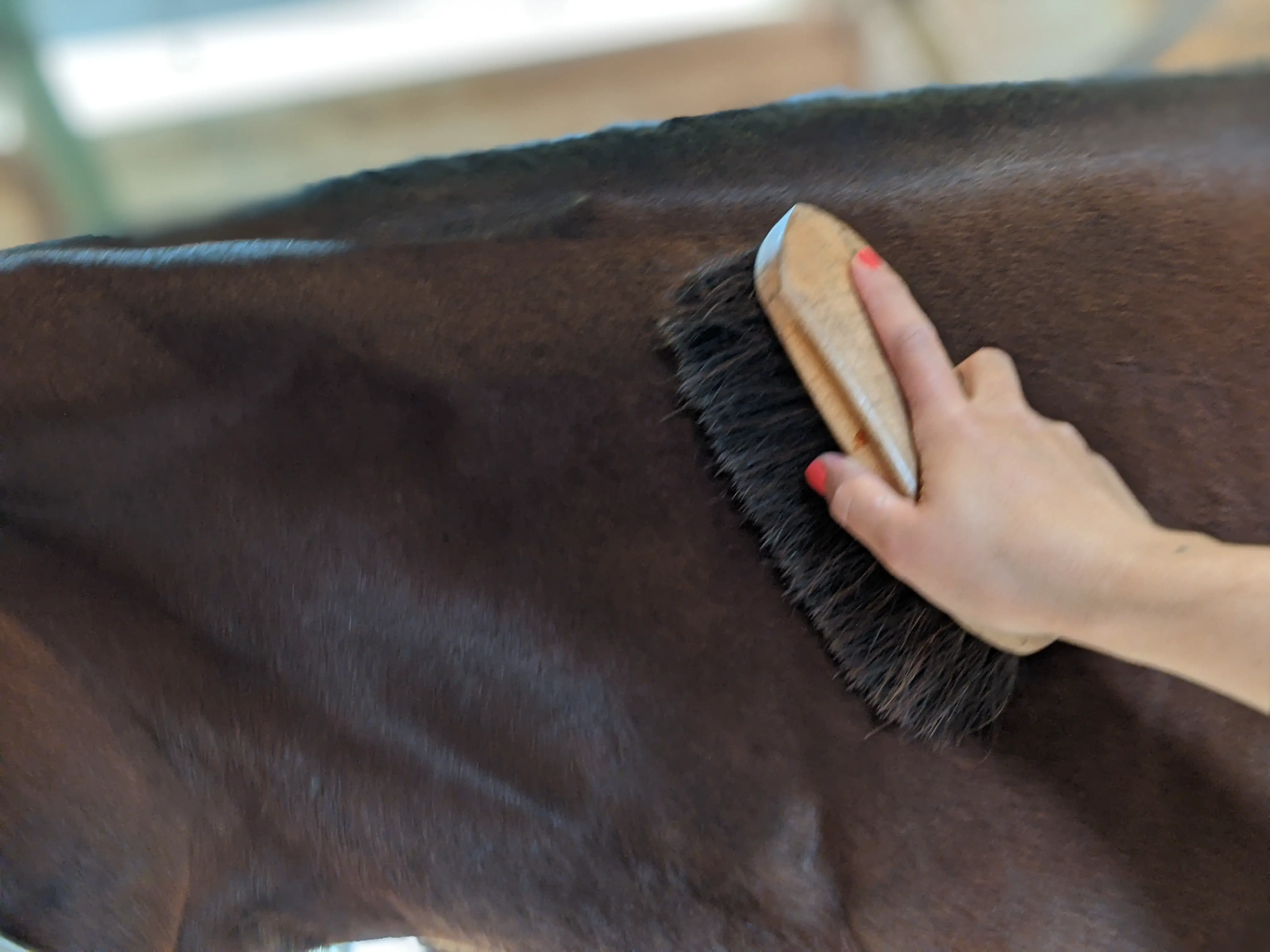
Horse Terms All About Riding
A Horse’s Gaits
Gait – a horse term used to describe the movement of the horse whether it be walk, trot, canter or gallop.
Walk – The slowest of all the horse’s gait and has four beats.
Trot – A two beat gait where the horse travels in diagonal pairs meaning the left front and right hind feet will be off the ground at the same time and vice versa.
Canter – A three beat gait, slower than a gallop but feels similar to galloping.
Gallop – A four beat gait, faster than a canter where all four feet are off the ground at the same time for a brief moment. The gallop and canter feel almost the same when riding other than the speed.
Riding The Different Gaits
Unmounted – To be off the horse.
Mounted – To be on the horse.
Posting – When riding the trot, riders will rise and sit in rhythm with the trot.
Diagonal – When posting the trot, a rider should be rising with the correct diagonal pair of legs. To be on the correct diagonal means the rider will rise when the outside (closer to the rail) front leg is forward.
Lead – At the canter a horse will either be on the left or right lead, meaning the left or right front leg will extend further than the other legs. When a horse is on the correct lead, their outside hind leg steps down first, followed by the inside hind and outside front legs (together) and lastly the inside front leg. If traveling left, the left front leg will be the last leg and will extend the furthest.
Flying Lead Change – When a horse changes canter leads without stopping, they change legs in mid-air.
Riding Terms
Equestrian – A person who rides horses.
Aids – The use of the rider’s body to queue the horse, for example using leg aids to ask the horse to move forward.
Equitation – The position of the rider in which they are the most effective.
Inside Aids – The aids on the side of the rider that are nearest the middle of the arena. If turning left, the left aids are the inside aids.
Outside Aids – The aids nearest the outside of the arena
Spook – when a horse becomes startles and either stops, jumps, turns around or backs up away from something they’re fearful of.
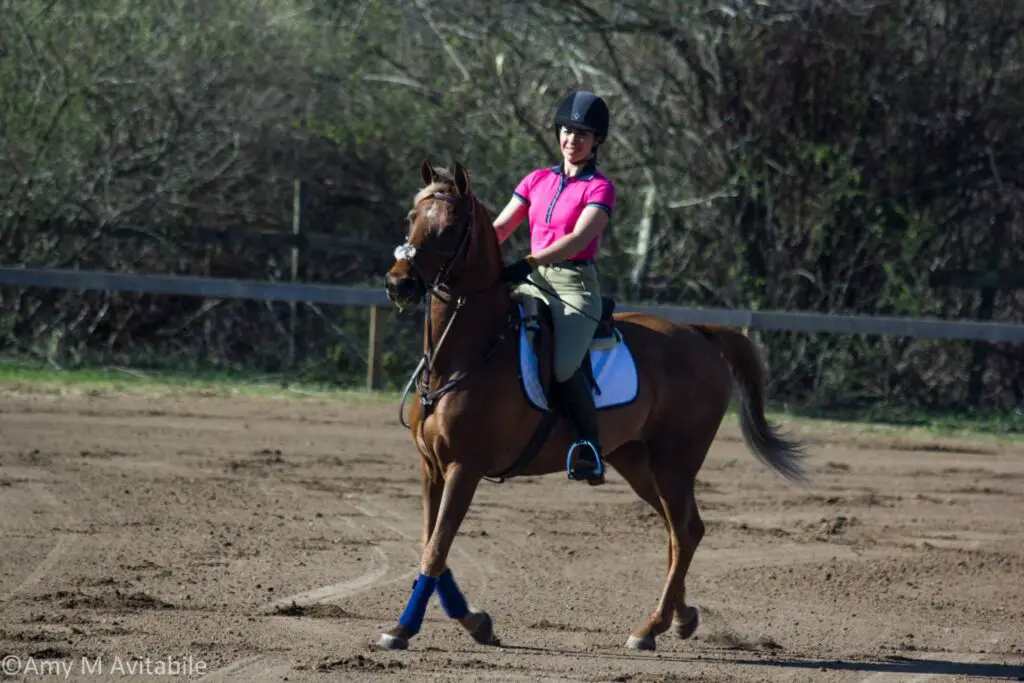
Disciplines and Types of Riding
English- A broad horse term used to describe a style of riding in a smaller, flatter saddle with stirrup irons. There are many sub-disciplines but English riding is most commonly known for jumping, dressage and fox hunting.
Western – Most people think of cowboys and the American West when they hear this term. And, that’s not wrong however, there are many disciplines within Western riding, just like in English riding. A western saddle is larger, has a horn in the front and leather stirrups. Some examples of Western disciplines include barrel racing, reining, roping, western pleasure and many more.
Bareback – to ride without a saddle.
Saddle Seat – A type of riding where the rider sits a bit behind the motion with their feet slightly further forward than in English riding. The rider holds their hands slightly higher to accommodate more up-headed breeds like Saddlebreds, Morgans and Arabians. Saddle Seat originated in the southern United States where plantation owners would ride for long hours.
General
Broke – A fully trained horse.
Green – A horse that has little to no training, typically young.
Arena – A large riding area with fencing and footing.
Round Pen – A small (60 ft) arena with a circular fence around it, used for training.
Bombproof – A bombproof horse is unflappable and is rarely or never spooky.
Horse Care & General Horse Terms
Hand – A unit of measurement which equals 4 inches and is used to measure the height of a horse.
Lame – An injured or sore horse that cannot travel correctly due to pain.
Sound – A healthy horse with no lameness.
Farrier – also known as a blacksmith or horse shoer, a farrier trims the horse’s feet and keeps their feet balanced. They also fit and put on horse shoes for horses that where them.
Groom – A horse term which means to brush and clean a horse.
Manure – another and more PC way to say poop!
Vice – any bad habit a horse has such as cribbing or weaving in their stall.
Colic – When a horse has abdominal pain due to gas or an impaction.
Teeth Floating – the process of filing a horse’s teeth down to keep them smooth so they don’t develop sharp hooks which will make their mouth sore.
Turn Out – Letting a horse outside to play and stretch their legs.
Paddock – A place where horse’s can be turned out, typically smaller than a pasture.
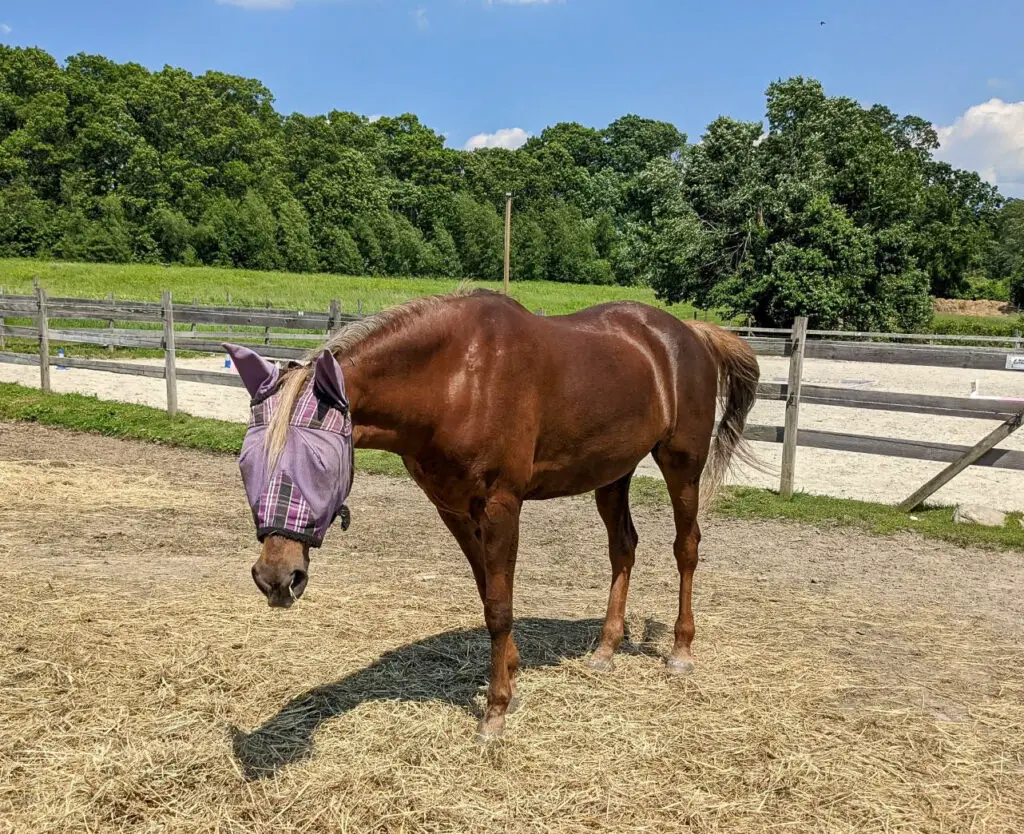
I hope you’ve found this post about horse terms helpful and informative! Want to suggest an addition to this article? Leave a comment below!
If you enjoyed this post, please share!
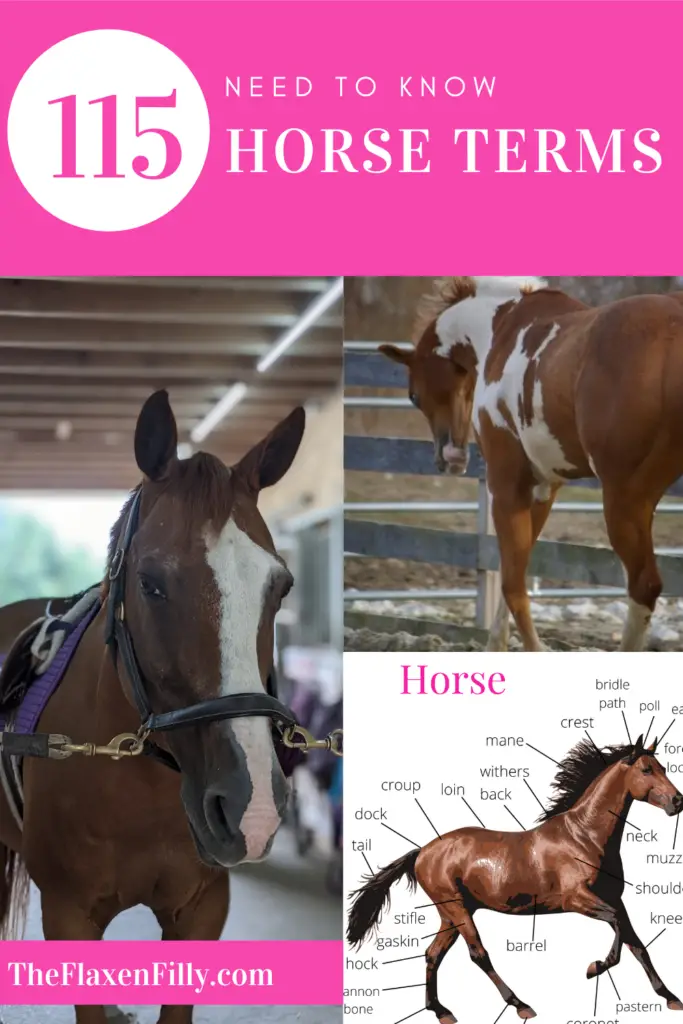
Check out these related articles!
How To Pick Your Horse’s Hooves Correctly
